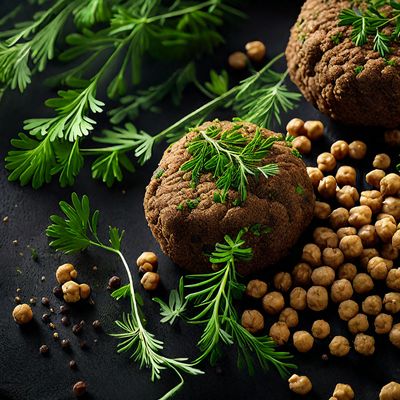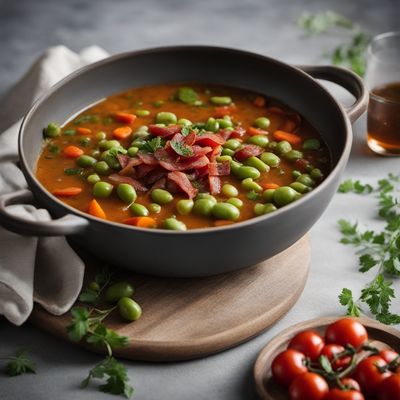
Ingredient
Broad beans (dry)
Hearty and Nutritious: The Dried Legume Powerhouse
Dried broad beans are large, flat legumes with a creamy texture and a slightly nutty flavor. They have a firm skin that softens when cooked, revealing a tender interior. Dried broad beans are often used in soups, stews, and purees, adding a rich and hearty element to these dishes. They can also be ground into flour or roasted for a crunchy snack.
Origins and history
Broad beans have a long history and are believed to have originated in the Mediterranean region. They have been cultivated for thousands of years and were highly valued by ancient civilizations, including the Egyptians, Greeks, and Romans. Broad beans were a staple food in many cultures and were often used as a source of sustenance during times of scarcity. Today, they are enjoyed worldwide for their nutritional value and culinary versatility.
Nutritional information
Dried broad beans are a good source of plant-based protein and dietary fiber. They are also rich in vitamins and minerals, including folate, iron, and manganese. Additionally, broad beans contain antioxidants that help protect the body against oxidative stress and inflammation.
Allergens
Broad beans may cause allergic reactions in individuals with a legume allergy. It is important to exercise caution when consuming broad beans for the first time and to consult with a healthcare professional if you have any concerns or known allergies.
How to select
When selecting dried broad beans, look for beans that are whole, unbroken, and free from any signs of mold or insect damage. Avoid beans that are discolored or have a musty odor, as this may indicate spoilage. If purchasing pre-packaged beans, check the expiration date to ensure freshness. It is also recommended to buy from reputable brands or suppliers to ensure quality.
Storage recommendations
To maintain the freshness and quality of dried broad beans, store them in an airtight container in a cool, dry place, such as a pantry or cupboard. Properly stored, dried broad beans can last for up to a year. It is important to protect them from moisture and pests, as these can cause the beans to spoil or become infested.
How to produce
Broad beans can be grown in a home garden or container. They require a sunny location and well-drained soil. Start by soaking the beans overnight to help soften their tough outer skin. Plant the soaked beans in the prepared soil, ensuring they are spaced adequately to allow for proper growth. Water the plants regularly and provide them with support, such as stakes or trellises, as they grow. Harvest the beans when they are fully mature and dry.
Preparation tips
Before using dried broad beans, they need to be soaked to rehydrate them. Start by rinsing the beans under cold water to remove any dirt or debris. Place the beans in a bowl and cover them with water. Allow them to soak for at least 8 hours or overnight. After soaking, drain the beans and rinse them again. They are now ready to be cooked according to your recipe. Dried broad beans can be used in soups, stews, salads, or purees. They can also be ground into flour or roasted for a crunchy snack.
Culinary uses
Dried broad beans are commonly used in Mediterranean, Middle Eastern, and African cuisines. They are a key ingredient in dishes such as Egyptian ful medames, Italian fava bean soup, and Moroccan bessara. Dried broad beans can also be used to make falafel or added to salads for an extra protein boost. In addition, they can be ground into flour and used in baking or roasted and seasoned as a nutritious snack.
Availability
Dried broad beans are commonly available in regions where Mediterranean, Middle Eastern, or African cuisines are popular. They can be found in grocery stores, specialty food stores, or ethnic markets. In some areas, dried broad beans may be more readily available in bulk bins or packaged form.
More ingredients from this category » Browse all

Azuki beans (dry)
The Tiny Powerhouse: Azuki Beans

Mung beans (dry)
The Mighty Green Legume

Soyabeans for consumption (dry)
The Versatile Legume

Jack beans (dry)
The Versatile Legume: Unveiling the Wonders of Jack Beans

Ervils (dry)
The Nutritional Powerhouse: Exploring the Versatility of Dry Ervils

Stink beans (dry)
The Aromatic Delight: Stink Beans

Lablab beans (dry)
The Versatile Legume: Lablab Beans

Runner beans (dry)
The Versatile Legume: Exploring the World of Dry Runner Beans

Rice beans (dry)
The Versatile Powerhouse: Rice Beans

Vetches (dry)
The Nutrient-Packed Legume: Dry Vetches

Monantha vetches (dry)
The Versatile Monantha Vetches

Black eyed peas (dry)
The Lucky Legume
Recipes using Broad beans (dry) » Browse all

New Nordic Falafel
Nordic-Inspired Falafel with a Twist of Middle Eastern Flavors

Favas à Algarvia
Savory Portuguese Fava Bean Stew

Sudani Spiced Fava Beans
Savor the Flavors of Sudan: Sudani Spiced Fava Beans

Frittedda Siciliana
Sicilian Spring Delight

Hyderabadi-style Spiced Ful Medames
Spiced Ful Medames: A Hyderabadi Twist on a Classic Egyptian Dish

Maneštra with Fava Beans and Fennel
Savor the Flavors of Croatia: Fava Bean and Fennel Delight

Fava Parada with a Shaanxi Twist
Savory Fava Bean Stew: A Shaanxi Delight

Fava Bean Stew with Chorizo and Smoked Paprika
Smokey Spanish Fava Bean Delight

Egyptian Spiced Fava Beans with Fresh Herbs
Savor the Flavors of Egypt: Fragrant Spiced Fava Beans

Fava Bean and Guanciale Stew with Channel Islands Twist
Channel Islands Fava Bean Delight: A Hearty Stew with Guanciale

Fava Bean Stew with Ionian Island Flavors
Mediterranean Delight: Fava Bean Stew with a Greek Twist

Habas con Calzones
Savory Spanish Fava Beans with Sausages